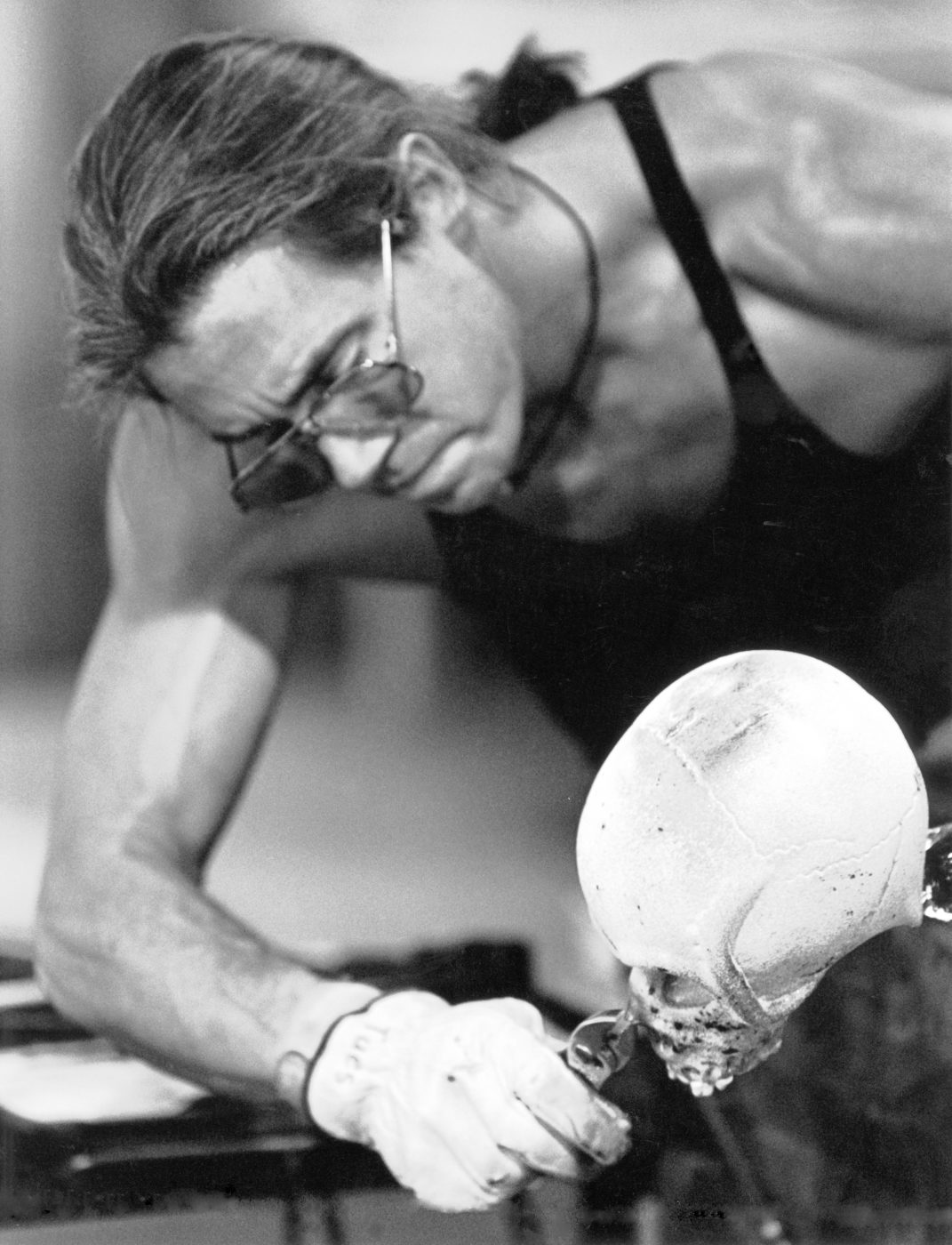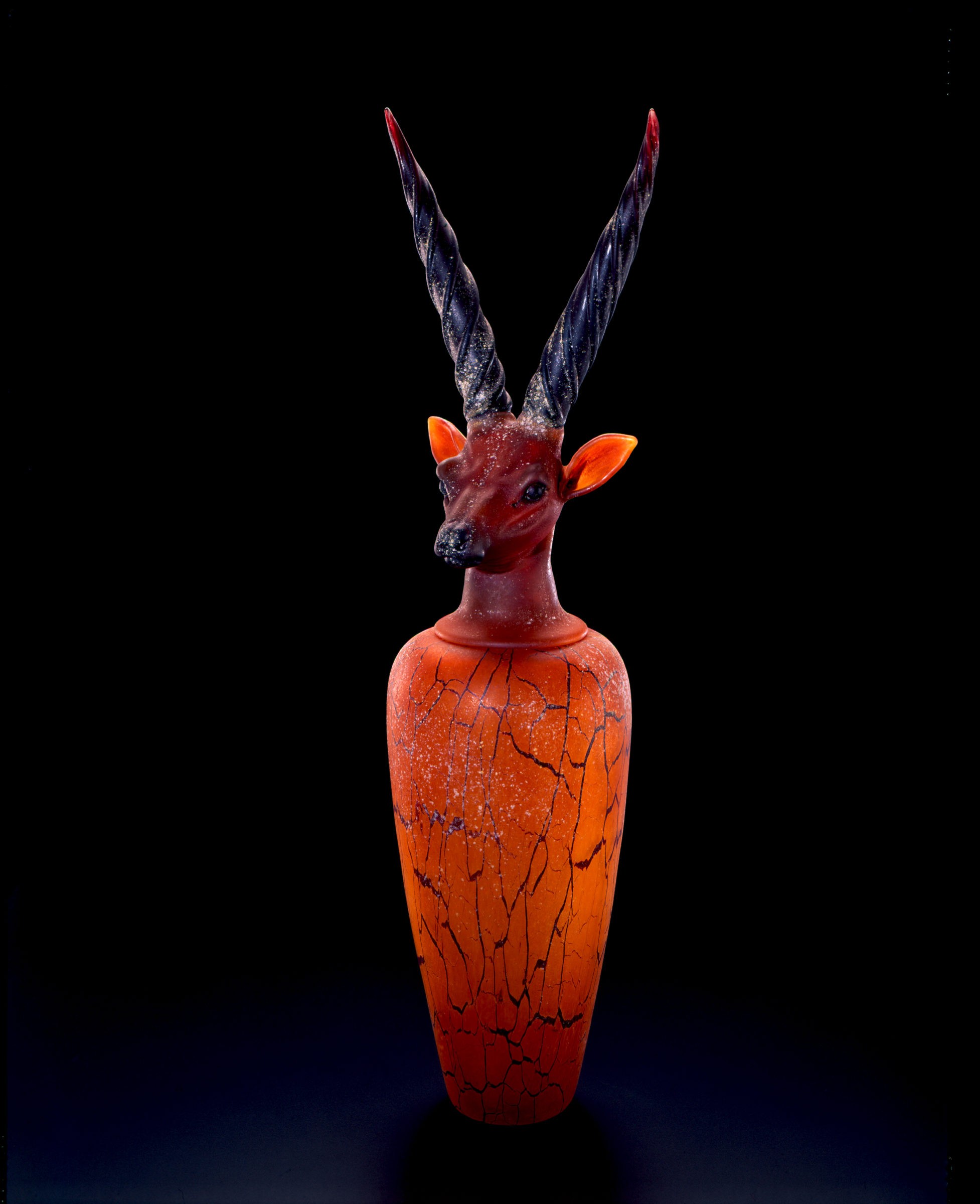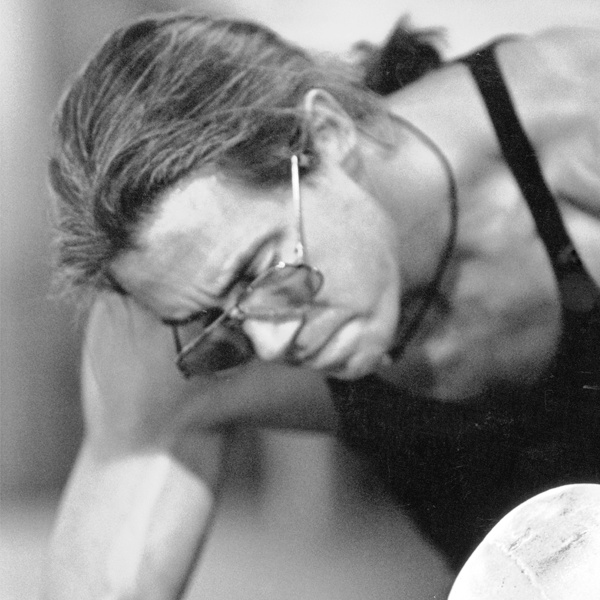In this 1982 interview with Paul Hollister, William Morris discusses working with molds for his large-scale pieces. Interview with William Morris by Paul Hollister, October 9, 1982. (Rakow title: William Morris interview [sound recording] / with Paul Hollister, BIB ID: 168577) Clip Length 08:45.
Time stamp: 00:00
Clip 1: William Morris discusses the challenges he and his team were experiencing maneuvering glass before it went into a mold. Clip length: 02:27.
William Morris (WM): But we’re working with some—small amount of people [inaudible], but also physically it was really demanding for my crew. One [inaudible] fellow I had on, we blew over four thousand pounds of glass in 14 days, and [inaudible]. So, physically it also kind of damages, so you have to be careful about that. Not to try to do too many [inaudible].
Paul Hollister (PH): Which—what is the physical problem? Is it in the, the blowing, at the point where you—
WM: No, it’s the carrying, and the maneuvering of the glass before it goes into the mold.
PH: As it grows.
WM: Yeah.
PH: Yeah. As it goes back and gets more on it.
WM: Well, it’s that last gather. And getting that heat built up to a point where it’s hot enough to fill the mold and get the proper definition and yet, you can still handle it. That’s the hardest part. See, I’ve ruptured my wrist from working [inaudible]. So that’s been a bit of a problem.
PH: There must be something technical in the Pilkington archive that might be of use to you to read on how large cylinders were blown, because they blew ‘em regularly, up to six feet—
WM: Yeah.
PH: —[inaudible] and so forth—
WM: Right.
PH: —and they didn’t have any trouble. And you shouldn’t have any trouble.
WM: Well—
PH: Not only that, they were absolutely even in thickness.
WM: Yes, but that’s, that’s the shape itself. My pieces are not even. They’re uneven in thickness.
PH: They’re uneven, right.
WM: But the thing is, that’s because where the glass grows, the [inaudible] volumes, areas in the mold, there’s no way I can get [inaudible]. Unless I shape the glass properly, you know, to begin with.
Time stamp: 02:30
Clip 2: William Morris discusses how glass responds to different types of molds. Clip length: 02:58.
William Morris (WM): You know, I think I just was thinking about like other materials, like outside metal. Steel. Using steel and having—trying to—cold, try heating with a torch. Steel, we’ve had some success with, but not much, because—as far as knowing your exact temperature, and also have to come—we use a steel pattern and outline and then wood on each side. So that the profile of the piece would be out of steel, but the faceplates would be out of wood. We didn’t, we didn’t try the faceplates out of steel yet, but the problem is knowing how hot you can get away with having it, because the glass will heat the material, and the glass will want to stick to it if it’s too hot.
Paul Hollister (PH): Mm-hmm.
WM: Okay? And like you said, it thickens inside. The wood—I mean, theoretically the wood’s better because you get the thick and thin spots because of the shape.
PH: Right.
WM: Okay? It—the cooling that takes place is really—it’s funny with the wood, because the glass really doesn’t come in contact with the wood like per se [inaudible]. Because the wood is moist, so there’s this intense pressure of steam that backs up from the wood. And what happens when it just [inaudible] sort of a layer—
PH: Mmm.
WM: —you know, that’s—
PH: An interface of steam.
WM: Yes, of steam. Which is coming in from all sides—
PH: Yeah.
WM: Now, some of the cracking—and you’re very right about this thick and thin spots, Paul, we’ve done some interesting things this last session working, there’s certain shape molds that even though the pieces survive and come out and they’re fairly even, they’ll eventually crack because of the stress of the shape of the mold, for some reason.
PH: It seems that with the wood, that the shapes were a little bit arbitrary, I mean, that they were not quite fluid enough. It’d be a place where I just got a look at one mold that was over at Heller [Heller Gallery, New York, New York].
WM: Mm-hmm.
PH: —yesterday, the only one that was open—
WM: Right.
PH: —and that one had real sharp corners, a real pocket.
WM: Yes.
PH: And those are the kind of places that, that you could have trouble, it would seem to me.
WM: Well, there are some of the pieces over there, and there’s two of ‘em in that chair that came out of that mold. That’s the only mold I sent over. I can show you what I mean, there’s two pieces that have—where you can see exactly what you’re talking about with sort of variation in thickness.
PH: So they’re over-articulated in a sense.
WM: Mm-hmm.
Time stamp: 05:31
Clip 3: William Morris discusses designing and building molds for his pieces. Clip length: 03:14.
Paul Hollister (PH): Who designs those, do you design them?
William Morris (WM): I design them, and then—
PH: John builds them?
WM: John builds them, but I’ll design ‘em off of a two-minute sketch that I’ll give him. There’s a lot of things that he has to make decisions on because of what he can put together. So he—there’s a lot of responsibility as far as his—you know, he does changes in the patterning, and that sort of thing. And—
PH: That’s why I think it may be the wrong, maybe medium—
WM: Material.
PH: —wood. Yeah.
WM: I’m sure I could find something that would be a little quicker to—
PH: Because what you do, then it goes and it gets either sharpened up too much—
WM: Mm-hmm.
PH: —or a detail gets eliminated because it simply can’t—
WM: Well, if I have the time and I can work directly with John, I will draw a full-scale drawing. And John will duplicate it perfectly in wood. He has that skill to do that. If it’s along the—if it’s along the lines, technically, I know—how we know how to build the molds better. You see, because we’re still just learning how to build the molds and put ‘em together.
PH: Yeah.
WM: So, he’s starting to learn what he can do, as far as construction and also, he needs the strength [inaudible] because the amount of pressure in these molds is unbelievable.
PH: Mmm.
WM: Unless they’re constructed right, they’ll just blow apart. The wood will blow open. The wood will actually [inaudible] chair will get completely split in half with the pressure that you see in his molds.
PH: What is the inner wood?
WM: The inner wood is cherry. And then we back with, usually a lot of plywood on the outside. Reinforcements. That’s how—so that’s put ‘em together so they don’t blow apart, because it’s a problem—
PH: Yeah. And I remember seeing all those huge c-clamps around them.
WM: Well, you see, and also, so the clamps, they’ve gotta come off of the form quickly. And if you use another material, and it’s heavy and heated up and difficult to move, the ways of opening it—
PH: But if you had a, if you had a ceramic one I was telling you about—not really ceramic, but I can’t think of these names of the sculpture stone stuff that were powder to mix with—
WM: Something like a hydrocal—
PH: Hydrocal, that was—or some kind of a thing that would be, would be receptacle to heat and amenable to heat, being heated up, but at the same time would be tough and you could just then screw in the actual clamp mechanism to that, so they would be a fairly easy process instead of putting clamps around it all—
WM: Oh, I see what you’re saying.
PH: —like furniture clamps—
WM: I see what you’re saying—
PH: You have things like big steel furniture clamps. But in this case, the clamp would be a part of the mold.
Permalink



